Date: 25th April 1942
Time: 23.50 hrs
Unit: 12 Staffel./Kampfgeschwader 3
Type: Junkers Ju 88A-6
Werke Nr. 3459
Coded: 5K + DW
Location: Llan-haylo Farm, Gwaunceste Hill, Builth Wells, Brecon.
Pilot: Oberleutnant Guenter Brixius - Killed.
(Born 02.07.1916.)
Navigator: Oberfeldwebel Fritz Kreienbrock. Captured POW.
(Born 24.11.1914.)
Radio/Op: Obergefreiter Paul Kochon. Captured POW.
(Born 30.08.1922.)
Gunner: Feldwebel Adolf Leibig – Killed.
(Born 05.08.1916.)
REASON FOR LOSS:
From information recently received from Phill Jones;
The crew subsequently became lost over England due to "Meacon" activity and at 22.35 hrs was claimed damaged by Cardiff HAA gun site J16B on Flat Holm Island in the Mouth of the River Severn (351/112 HAA Rgt). It was initially picked up by the Gun Laying Radar at a range of 42,000 yards and engaged with 6 rounds of 4.7" at a height of 8000 feet. The target, which was tracked through 180 degrees, then lost height disappearing at an altitude of 6000 feet and a distance of 1900 yards before crossing the coast near Chepstow. The Junkers then flew up the Wye Valley before being shot down by F/O Wyrill and Sgt Willins in Beaufighter X7933 of 255 Squadron.
A dear friend of ours, Phillipa Hodgkiss of the Marches Aviation Society relates the sad aftermath: Radnorshire was a Welsh Border county now part of Powys, a place of castles, thin upland sheep pastures and windswept hills. Long ago it was disputed land where Anglo-Normans stalked Welshmen in bloody skirmishes.On a cold night in April 1942 Britons stalked Germans in an equally deadly affray. It ended when a blazing Junkers 88 disintegrated on a hillside a few miles from Builth Wells. This is arguably the most excavated site of a German crash in the country. The ashes of Lubeck were hardly cool, following a visit from R.A.F Bomber Command, before an infuriated Hitler ordered the series of reprisal raids which have gone down in history as the "Baedeker Raids". Lightly defended towns of historical or architectural interest were selected for attack, including Norwich, Exeter, Canterbury and Bath. The loss rate for bath raid was 2.6% and of the few aircraft that fell to the defences that night we are concerned with just one. For the raid the Luftwaffe had assembled virtually every aircraft capable of flying double sorties and as had been the case with the R.A.F.'s first 1,000 Bomber Raids. One such aircraft was the 5K + DW of the IV Gruppe, 12 Staffel KG3 "Blitz". The aircraft bore its Werke Nr. (serial number) 3459 on the fin, with the black/green tops and pale blue undersides were heavily daubed with matt black distemper to prevent reflections from searchlights.
The aircraft was one of the less common marks, being a Ju 88A-6 manufactured the previous year. At 21.30 hours the bomber left Brussels Evere airfield and the crews settled to their various tasks in the cramped cockpit. The pilot's fingers gripping the inverted U of the control column bore a slender gold ring with a setting for three stones. Oberleutnant Guenter Brixius was leaving the continent of Europe for the last time, but the ring his mother had given him as a keepsake was to go back nearly 40 years
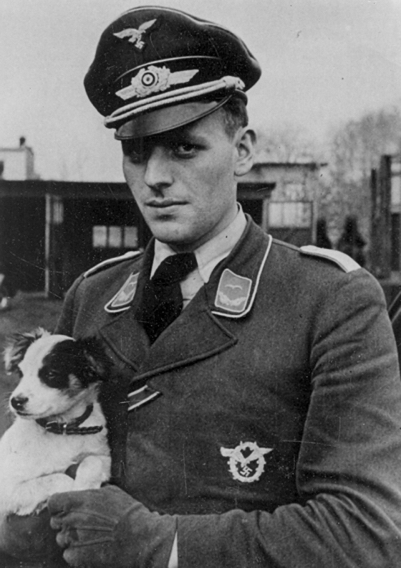 cc
cc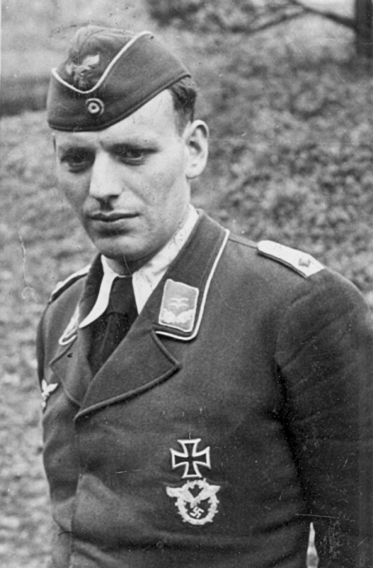
Pilot of the ill-fated Ju 88, Oblt Guenter Brixius (via Brixius)
The brief for the German crew was to attack the historical City of Bath. Behind Brixius and back to back with him was air gunner Feldwebel Adolf Leibig and on his left, in front of the radio equipment was young Gefreiter Paul Kochon. In front of Kochon and seated facing forwards, a little to the right of and behind his pilot, was observer Oberfeldwebel Walter Kreienbrock.
Mission accomplished the aircraft kept a north westerly heading towards the more lightly defended area of Wales, perhaps intending to sweep south-easterly towards friendly territory avoiding the contested air space of the south east. At 10.35 p.m. Beaufighter X7933 of No. 255 Squadron piloted by F/O Wyrill with Sgt Willins as radar operator, took off for practice interceptions from High Ercall, being taken over by Honiley GCI at 11.00 p.m. Almost at once the pilot was passed to Comberton who had a "Bogey" an unidentified aircraft about twelve miles away. In the Hereford area a contact was obtained at 15,000 feet, about three miles off. F/O Wyrill reduced speed from 230 mph to 160 mph and shortly afterwards saw the glow of exhausts which was typical of a Ju 88 or He 111. The aircraft was weaving and not showing IFF and it was identified as a He 111. A two second burst from 100 yards astern scored hits causing the Ju 88 to take evading action and disappear in the mist. Radar contact was maintained and visual contact re-established. A four second burst was given from the same position as before, closing to 50 yards, when the enemy aircraft burst into flames and went down vertically. One parachute was seen to emerge before a brilliant flash on the ground showed where the aircraft exploded.
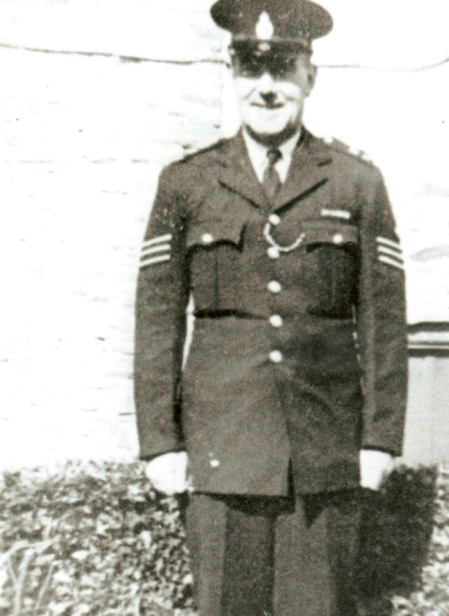
PC Creed pictured as Sgt. (Jones)
Even in the remote Radnorshire parish's the war pervasive deprivations brought gloom and despondency but at least the pubs were still open and at midnight PC Creed, one of the 22-man Radnorshire force, went out into his garden to fetch firewood. He had just come back from the village of Hundred House to see the pubs out, still in his tunic.
From the night sky away down the Wye Valley came the rumble of aero engines and he deduced from the uneven throb that it may be a Jerry. Remote, Radnorshire may have been, but it was nevertheless a through route for bombers travelling to Liverpool and the North West. Creed recalls that the pheasants called uneasily to each other in the coverts at distant detonations during the bombing of Cardiff and Swansea. Even as he waited, the engines seemed closer than usual and as he looked up there suddenly sprang glowing streaks of fire across the night sky followed by the heavy clatter of cannon fire. There seemed to be machine gun fire too. He called to Mrs Creed that there was a scrap going on and before there was time to wake their sleeping sons there was a blast of sound as an aircraft came low overhead, a dark blur against the sky. Creed saw at once it was a Beaufighter. The other aircraft was now burning brightly and curving downwards back in the direction from which it had come.
With appalling violence it crashed into the side of Gwaunceste Hill above the village. The impact was heard 20 miles away in Brecon and the flames towered up.Fatigue forgotten, Creed told his wife to phone Constabulary Headquarters and report the crash. Anticipating his need a neighbour came up with a car and with a few Home Guard members the party made its way uphill to where the wreck still blazed, ammunition flying in all directions in the heart. There was no way of putting out the flames so they watched it burn. When the flames died down a little, Owens, one of the Home Guardsmen went over to the debris with it's nauseating smell. The tail stuck up, smoke blackened, he thought, in a shallow crater and from a label they determined that it was a Junkers Ju 88.
There was nothing more to be done until the daylight so Creed went to get a couple of hours sleep. When he entered his home, which also served as the Police Station, he was surprised to find his wife custodian of two german airmen. Decorations, flight badges and side arms lay on the table with their other possessions. A youthful Paul Kochon was having his wounds dressed by Zoe Owens, sister of one of the Home Guardsmen. Still in shock after his narrow escape from death and with a shell splinter in his upper arm Kochon had fainted when Zoe approached him with a knife to cut away his sleeve. Kreienbrock had descended near the main road to give a courting couple, returning from Builth, the fright of a lifetime. Kochon had come down near the isolated farm of Ffynnonav and had kicked at the batchelor farmer's door until, bleeding and exhausted he was admitted.
Further down the main road towards Builth, Sgt Weale of the Home Guard, with his platoon marched purposefully into action. Seeing Kreienbrockís abandoned parachute Weale spread his men out in an encircling movement, cautioning the troops against presenting an easy target for the enemy. But Kreienbrock was already lodged safely in the Police Station, with an escort on its way from Llandridnod Wells, so he was longer a menace. Kochon was escorted to Builth Cottage Hospital for the shell splinters to be removed. Just after dawn Creed set off again up the hillside, meeting the first of the souvenir hunters coming down with their rich spoils as he left the main road. Unwillingly they re traced their steps to replace the spoils, but for days others came from the hill farms and villages for miles around to see the tangible remains of the enemy machine and hopefully loot some of it. Not a squeamish man, Creed, who had attended many an autopsy, gathered the remains of the two fellow human beings and prepared them for burial as best as he could at the granary at Llanhailo Farm. Shortly afterwards he, Owens, Billy Walker, an army driver and another man bore the remains of their former enemies to their first resting place in the churchyard at Glascwm.
 cc
cc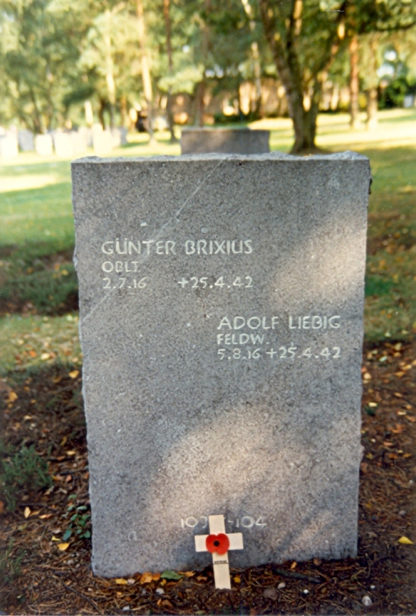
Here they were to lie for a generation until they were taken, with other German war dead, to the Deutsche Soldatenfriedhof at Cannock Chase.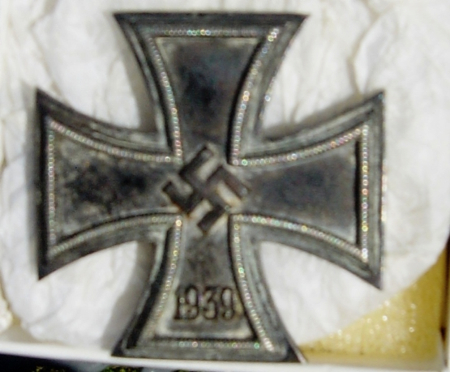 cc
cc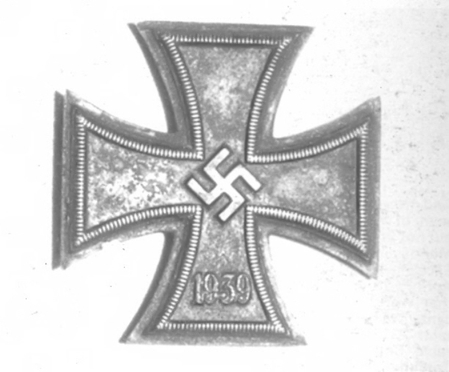
Iron Cross 1st Class which was found on the floor of the granary at Llanhailo Farm after the remains of the two fallen airmen were removed.
Almost forgotten, but not quite with the resurgence of interest in things relating to the war, the Buftons, of Llanhailo began to receive visitors who asked about the crash and who dug for relics.The hill was now covered with conifers, part of the forestry plantation which had covered the scars of war with a carpet of pine needles. The site, in a firebreak along a line of a footpath, was turned over regularly by the new group of searchers and a first-aid kit and profusely stamped signal pistol recovered from the site are at present in the R.A.F. St. Athan collection. Saddest relics of all perhaps were the rings. The writer first visited the site in the winter of 1978: except for a few exploded Mauser cartridges little of interest could be seen, but passing the site one October afternoon the following year I spent a few minutes in the half light scratching in the surface earth. More exploded cases, and what appeared to be a piece of brass wire. I picked it up and there was a glint of gold. A signet ring with a setting for three stones, it had been ripped open violently and distorted at the hallmark.
Out of the wood I sat and wondered about the young man who had worn it and who had met such a terrible end. Stumbling down to the road I resolved to return the ring from whence it came. Two months later, visiting the site under almost identical circumstances the same thing happened, just under the surface was a greenish black circle of metal; at first I thought it was a pipe gasket but the weight in my palm told otherwise.
Cleaned of carbon the gold shone and this too had a hallmark.I wrote a letter to the secretary of the KG3 old comrades association and with his reply came the address of the pilot's brother, Herr Ulrich Brixius. The reply to my letter was a sad one and he was not sure about the ring being his brothers, but at the request of the Deutsche Dienstelle, to whom I had also written, I sent both rings by Registered Post to Berlin. Some months later the Dienstelle wrote to say that the signet ring was the pilot's and the wedding ring belonged to the gunner and both had been passed on to the next of kin.
It was during the long school holiday of 1982 that we went to the site last, Ian and Martin and two school friends going over scattered wreckage looking for writing. Eight year old Martin called out that he had found a plate with 88 on it and it was greeted if not with hoots of derision, at least with a certain amount of scepticism. A close look and careful cutting and filing of folded metal at home revealed it for what it was, a Werke plate, giving final, incontrovertible evidence of the aircraft serial and manufacture.
Note: During our visit in 1989 we found many scraps of torn airframe fragments, together with exploded 7.9mm ammunition. On leaving the site we noticed a square piece which looked like a manufacturer’s plate, on turning the piece over we found to our disbelief that it indeed was one.

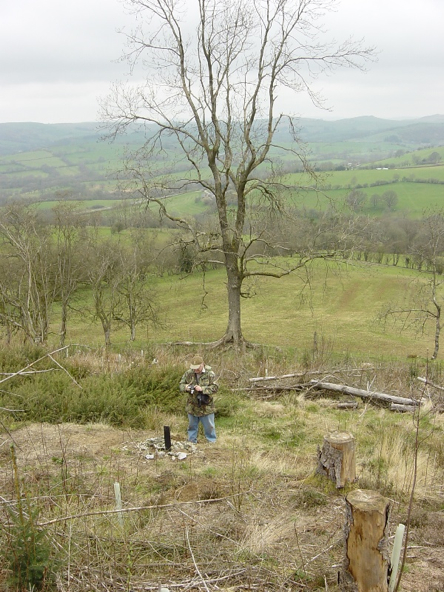 cc
cc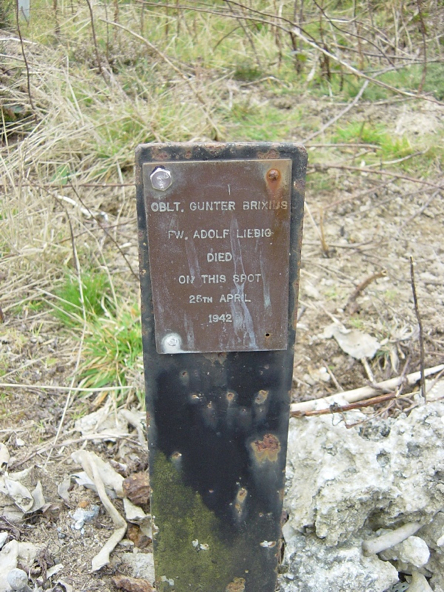
Crash site location pictured April 2012, the fir copse has now disappeared. (P Jones)
Burial Detail: Both airmen who were killed share a grave at the German Military Cemetery, Cannock Chase, Staffs.Block 7 103/104
Researched & compiled by Melvin Brownless with special thanks to Philippa Hodgkiss (now Wheeler), Phill Jones, and not forgetting Ulrich Brixius. (May 2013).


The British Library is preserving this site for the future in the UK Web Archive at www.webarchive.org.uk All Aircrew Remembered on our Remembrance pages, are therefor not just remembered here, but also subsequently remembered and recorded as part of our nation’s history
and heritage at The British Library.

